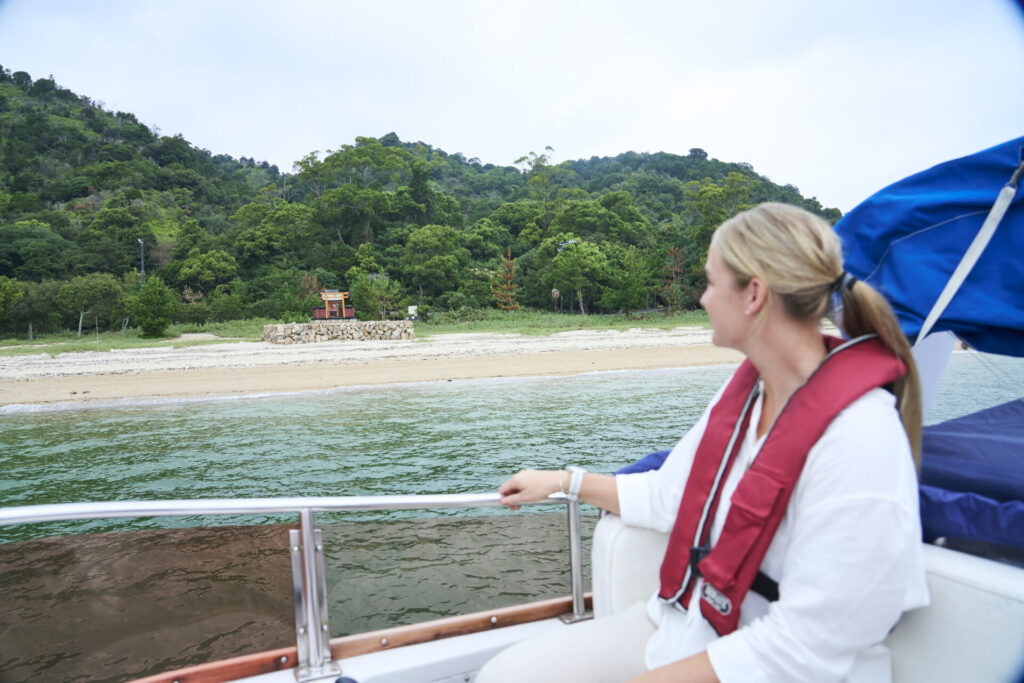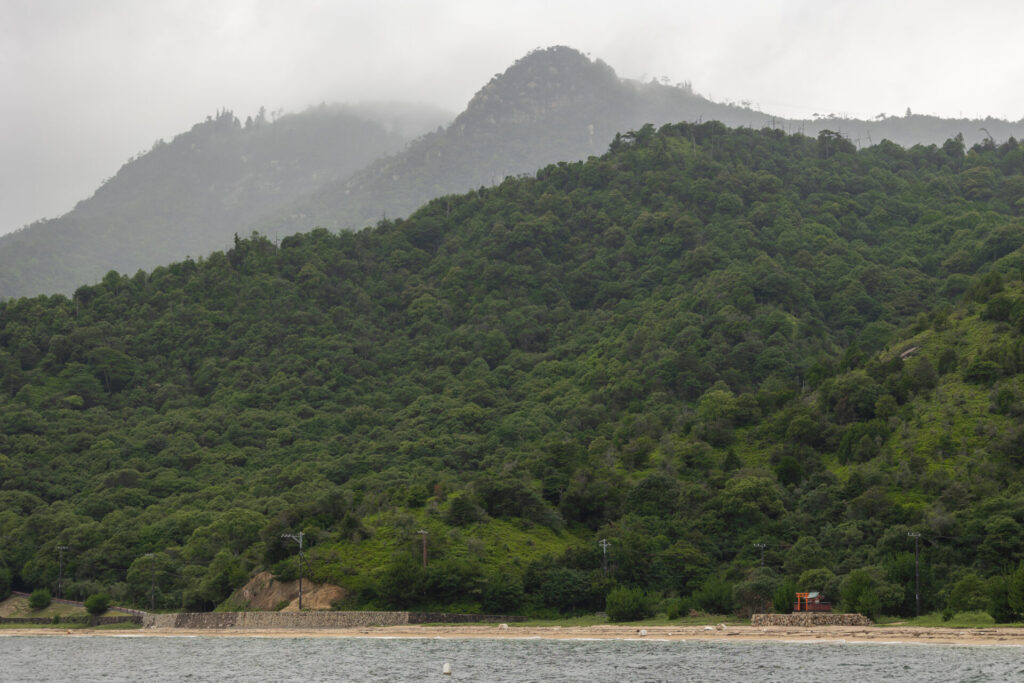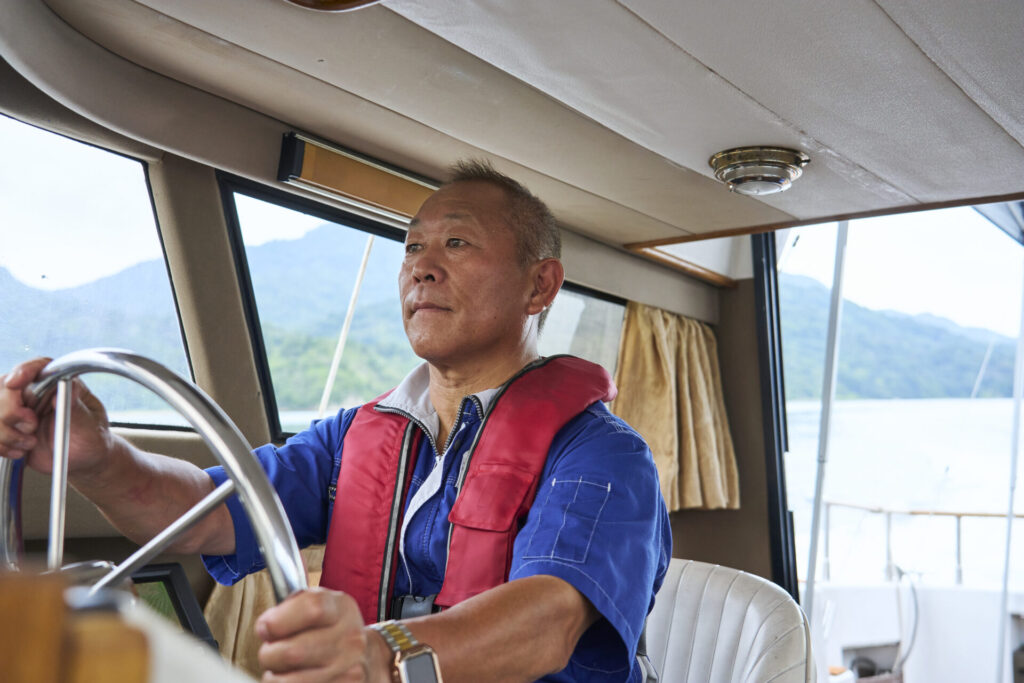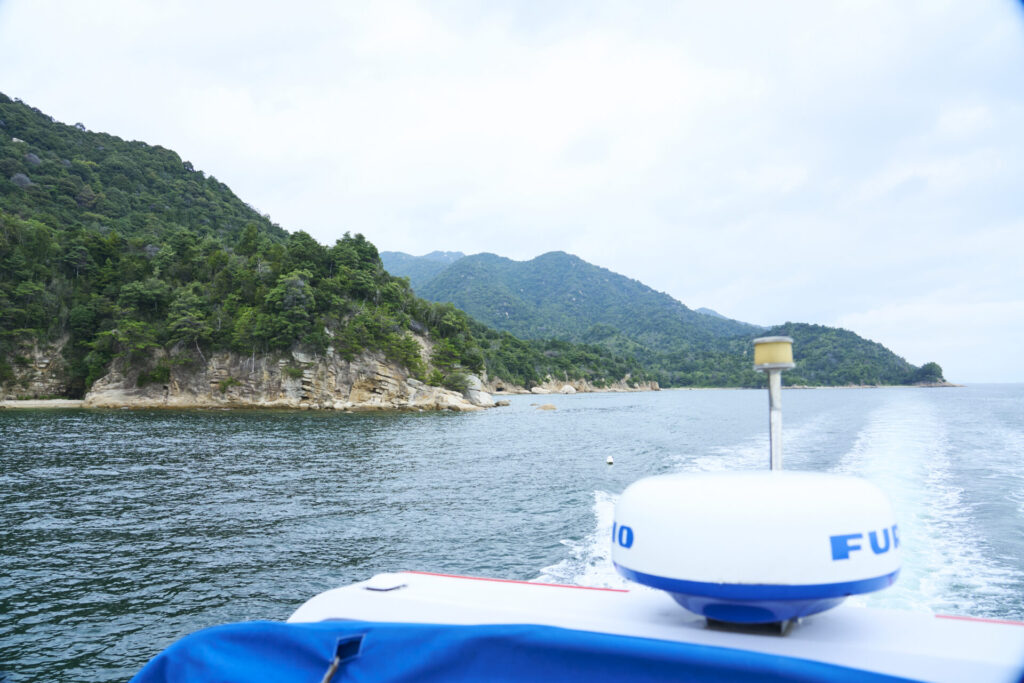
Miyajima from the Sea — A Cruise Inspired by Respect for the “Island of the Gods”

塚本 雅彦
Masahiko Tsukamoto
Miyajima [Hiroshima]
Masahiko Tsukamoto
Born in Etajima, Hiroshima Prefecture. President of T’s Company Co., Ltd. During the COVID-19 pandemic, he launched a cruising-based tourism business to offer sea-view worship experiences around Miyajima, an island he has revered since childhood. He also founded the Hiroshima Cruise Safety Promotion Council to promote safe marine tourism and continues to advocate for enjoyable and secure experiences on the water.
When tourism on Miyajima came to a halt during the COVID-19 pandemic, Masahiko Tsukamoto, who runs an automobile sales company, decided to repurpose his privately owned cruiser to launch a new kind of tourism: small-group private cruises. With deep reverence for Miyajima—long cherished as the “Island of the Gods” since his childhood—he now shares the beauty of Itsukushima Shrine as seen from the sea. This is the story of Tsukamoto’s driving force: his unyielding spirit of challenge and his devotion to the island.
A New Form of Tourism Born Amid the Pandemic
Tsukamoto’s entry into the tourism business began in 2020, during the COVID-19 pandemic. Although his main business—automobile sales—was not severely affected, he was deeply saddened to see tourism in his hometown of Hiroshima come to a near standstill.
“The number of visitors to Miyajima had dropped to almost zero. I couldn’t stop thinking about how I might be able to help,” he recalls.

At that time, one idea came to mind: the 12-passenger private cruiser his company already owned. Originally used for employees and clients, he decided to register it with the Ministry of Land, Infrastructure, Transport and Tourism, allowing him to operate it as a licensed irregular-route service.
During a time when large group travel was restricted, his “private cruise” concept—where families and small groups could enjoy the sea together—offered both safety and exclusivity. When Japan later introduced a government travel support program with discounts for vaccinated travelers, Tsukamoto’s cruises perfectly matched the needs of those who wished to travel safely while avoiding crowds.
He also introduced drone photography to capture unique aerial views of the journey. This new approach, which allowed guests to preserve rare perspectives of their trip, drew strong interest from those hesitant to visit crowded destinations.
“At the time, no one else was offering a cruise that let people view Miyajima from the sea. I simply wanted others to see the same scenery I had admired as a child,” says Tsukamoto.
His initiative soon caught the attention of the Miyahama Onsen Association on the opposite shore of Miyajima. With visitor numbers plummeting, they reached out to him, hoping to make “cruising” a new local attraction for their guests.
A Deep Bond with Miyajima, Etched Since Childhood
For Tsukamoto, Miyajima has never been just a sightseeing spot—it has always held a special meaning in his life.
Born into a fisherman’s family on Etajima Island, about eight kilometers off the coast of Miyajima, he grew up surrounded by the sea. Every year, his family would take their boat out for the Kangen-sai Festival, a grand maritime ritual of Itsukushima Shrine. Dozens of fishing boats would gather near the great torii gate, tied together with ropes. Young Tsukamoto would hop across them to step onto the island, surrounded by rows of bustling food stalls and the festive air that filled every corner of Miyajima.
“That scene is still vivid in my memory,” he says. “For fishermen, Miyajima was a sacred place—a site to pray for safety at sea and good catches. It was intertwined with everyday life.”
These early experiences instilled in him a deep sense of reverence for Miyajima as a “divine island.” So when he saw the island deserted during the pandemic, he couldn’t stand by and do nothing—he felt compelled to act.
“The view of Itsukushima Shrine from the sea—that is its true form,” Tsukamoto explains. “In the Heian period, master builders designed the shrine so that it would appear to float on the sea at high tide. When visitors see the vermilion pillars and white walls reflected on the water, they can truly understand its beauty.”
(Note: The Kangen-sai Festival, held annually on the 17th day of the sixth lunar month at Itsukushima Shrine, is one of Japan’s three great boat festivals. It reenacts the elegant court music and rituals of the Heian period on the sea.)
Exploring Miyajima with Reverence — A Journey Through History and Beauty
Tsukamoto’s deep respect for Miyajima is reflected in every aspect of his cruise tours.

The signature plan, “Sea Worship Experience at Itsukushima Shrine,” is designed from the visitor’s perspective. The boat sails to the best viewpoint where the shrine can be seen through the torii gate, then approaches close enough for guests to feel its scale and the texture of the natural wood. When the tide allows, the vessel passes under the great torii, offering a once-in-a-lifetime view of the floating shrine. Many participants describe the experience as “a dream come true” or “a truly sacred moment.”
“Today, many visitors walk to the torii at low tide, but originally people worshipped from the sea,” Tsukamoto explains. “We ask guests to remove their hats and follow the traditional etiquette of two bows, two claps, one bow—a gesture of proper respect to the gods.”
Before approaching the gate, he turns the rudder left and circles the boat three times—following the ancient Kangen-sai custom of purification. Like washing one’s hands at a shrine’s basin, this act symbolizes cleansing before worship.
“Itsukushima Shrine has stood for over a thousand years,” he says. “Seeing it from the sea reveals the craftsmanship of our ancestors and the depth of faith that has sustained it. I want people to feel that reverence for the island naturally.”
Another popular plan, the Kangen-sai Viewing Cruise, allows guests to follow the majestic procession of boats accompanied by elegant court music. At night, the scene becomes even more enchanting—fire torches flicker across the waves, and rowers splash seawater to protect the boats from the sparks, a sight only visible from the sea.

There is also a full-circle cruise around Miyajima, revealing untouched forests and secluded coves. Many guests are astonished to see the island’s wild, sacred side, often saying, “I never knew Miyajima had such depth.” Drone footage adds to the wonder, giving passengers the sensation of being embraced by the “Island of the Gods.”
“My wish is to support Miyajima’s tourism,” Tsukamoto says. “Most visitors come for a day trip, but I want them to take time and truly experience the island’s spirit from the sea.”
His tours now include routes departing from ports near Hiroshima Station and plans that connect directly to nearby museums—all driven by his desire to share Miyajima’s beauty more deeply with the world.
Safety First — The Foundation of an Enjoyable Cruise
As Tsukamoto’s cruising business took shape, one principle guided every decision: safety above all else.

“Boats are tools that support tourism,” he emphasizes. “We must never allow accidents to happen. Safety should always come before anything else.”
In recent years, Japan’s cruising industry has seen accidents caused by engine troubles and groundings. Determined to prevent such incidents, Tsukamoto spearheaded the creation of the Hiroshima Cruise Safety Promotion Council.
With years of experience as a Maritime Safety Instructor appointed by the Japan Coast Guard’s 6th Regional Headquarters, he understood that even a small lapse could lead to a major accident.
The council works closely with the Coast Guard to hold safety workshops for local operators and distributes a shared sticker symbolizing certified safety standards among member vessels. His leadership and long-standing contribution to maritime safety earned him official recognition and an award from the Japan Coast Guard.
“It was the first safety promotion council ever established within the jurisdiction of the Chugoku District Transport Bureau,” Tsukamoto explains. “In the past, safety awareness varied from operator to operator. But if we truly think about our guests, maintaining absolute safety on the sea must come first. Only then can marine tourism offer real peace of mind.”
He continues to take the lead in promoting marine safety, believing that it is essential for revitalizing tourism across Hiroshima—including Miyajima and Miyahama Onsen—from the sea.
The Feeling of Being “Inside the Sea” — The Charm of a Small Boat
On summer afternoons, southern winds sometimes stir the waves near the Hatsukaichi Bridge, the departure point for Tsukamoto’s cruises. Yet as the boat draws closer to Miyajima, the sea suddenly calms—the surface turns mirror-smooth, shimmering with light.
“It feels as though this area alone is being specially protected,” Tsukamoto says with a smile.
The waters in front of Miyahama Onsen are equally stunning. Although the nearby coastline includes industrial zones, the sea remains remarkably clear; the water churned by the propeller glows a luminous blue-white.

Guests can experience this beauty up close aboard Tsukamoto’s twelve-passenger cruiser. The small vessel brings the sea to life—spray splashes against their hands and faces, creating a vivid sense of being part of the ocean itself. To share this sensation more widely, Tsukamoto even developed a mini tugboat that anyone can operate without a license.
Constantly brimming with ideas, he continues to explore new ways to energize local tourism. The driving force behind all his efforts is simple yet profound: respect for Miyajima.
What Do We Wish to Pass On to the Future?
When asked what he hopes to carry into the future, Tsukamoto answers without hesitation.

“I owe everything to the sea,” he says. “It has raised me. Sharing the beauty of this sea and of Miyajima through tourism—that’s both my mission and my joy.”
He speaks with deep gratitude for the many people who have supported his journey.
“None of this would have been possible without the connections I’ve made along the way. Meeting and being supported by so many people has made me realize again how wonderful the sea is—and it has strengthened my respect for Miyajima even more.”
Pausing thoughtfully, he adds:
“Going forward… I hope to find others who share my vision and can carry it on. For that to happen, I must keep generating ideas and continue leading the way.”
For Tsukamoto, this is not simply a business. Through his cruises, he seeks to pass on the spirit, history, and culture that have long been intertwined with the sea and Miyajima.
To lead the way and keep challenging oneself is never easy—there are times when the waves seem too strong to push through. Yet, it is his unwavering respect for the island and the sea that keeps the vessel moving forward, guiding it steadily toward the future.
